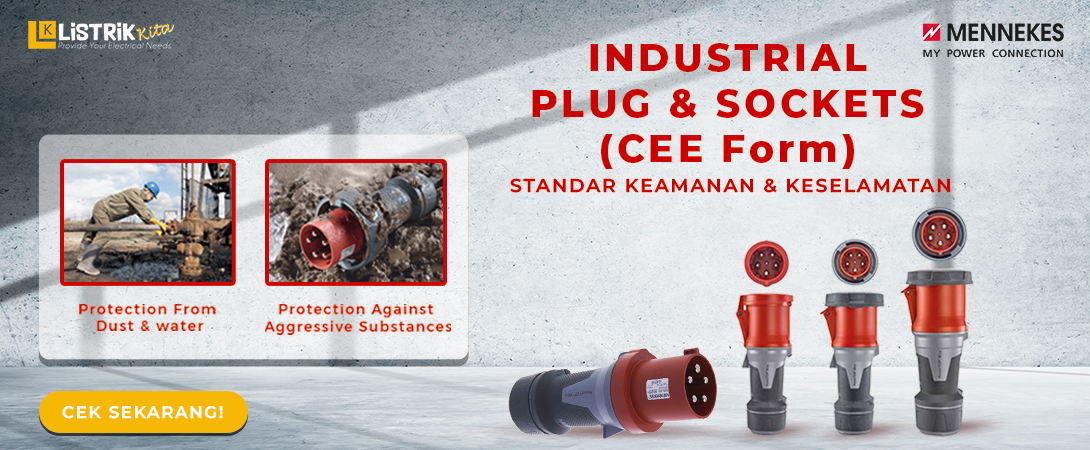
In our daily lives in factories, workshops, buildings, and so on, we often encounter power sockets and plug sockets for connections between cables or power. But sometimes we are not aware of the standardization of the plug socket. In industrial areas or large or important loads such as generators, gondolas, 3-phase machines, and so on, a current or voltage is required, which is usually different or larger than in home applications. Apart from considerations from the electrical side, there are also considerations from the construction side of the plug socket equipment, such as resistance to high working temperatures, dust and water, impact, flames, the obligation to use grounding for safety, and so on.
This is what makes the Mennekes industrial plug socket have different standards from home or residential plug socket applications. IEC 60309 is the standard used for industrial plug sockets. This standard was developed in the 1960s in Europe. The Minister of Health, which was established in Kirchundem, Germany, in 1935, focused on industrial plug sockets, initially using the DIN standard in the form of a flat pin connection. In 1966, the Minister of Health was involved in standardization and changes to IEC 60309 or CEE (Certification of Electrotechnical Equipment) plugs, or CEE form, which we know today in the form round.
Mennekes' Industrial Plug Socket, which is regulated in the IEC 60309 standard, namely:
- All plugs, sockets (receptacles), and inlets are either portable (can move) or fixed (still).
- Voltage not more than 1000V AC/DC, frequency not more than 500Hz, and current not more than 800A. The voltage is regulated via color code (example: blue for 220 VAC, red for 400 VAC, yellow for 110 VAC, and so on).
Picture. Clock position for voltage range indication and color for voltage magnitude

- Standard current amounts are: 16A (minimum), 32A, 63A, and 125A.
- The range of voltage quantities is explained in a clockwise direction. Example: 6 o'clock (which is commonly used) for a voltage range between 346-415 VAC (for 5 pins), while 3 o'clock (which is commonly used in cooling containers) is for a voltage range of 380 VAC at 50 Hz and 440 VAC at 60 Hz.
As an initial manufacturer and specialist in industrial plug sockets, Mennekes has a complete product portfolio for the needs of the types above.
Apart from the various options above, IEC 60309 also carries out various tests to ensure the construction of the Mennekes plug socket is strong for industrial applications or large loads.
Some tests include:
- Resistance to working temperatures ranging from -25 to 40 degrees Celsius The Minister of Health himself carried out more tests than IEC standards to ensure the strength of the plug socket construction.
- Mechanical resistance to impact, pressure, and dropping. The strong construction from Mennekes ensures that the plug socket continues to work well in outdoor conditions that are prone to the risk of being crushed and so on.
Picture. Mennekes plug socket crushed by truck

- Resistance to dust and water IP (Ingress Protection): Industrial plug socket standards start at IP 44 (spash-proof). Mennekes is available in various options, such as IP 44 and IP 67 (water-tight), which are resistant to momentary submersion.
- Resistance to flame GWT (Glow Wire Test) The test was carried out by burning an industrial plug socket with a burning wire at 6500 °C. Industrial plug sockets that follow standard rules must not burn for 30 seconds.
As an initial manufacturer and specialist in industrial plug sockets, Mennekes has a complete product portfolio for the needs of the types above.
Apart from the various options above, IEC 60309 also carries out various tests to ensure the construction of the Mennekes plug socket is strong for industrial applications or large loads.
Picture. Flame resistance testing (Glow Wire Test) of Mennekes plug sockets

And there are many more tests carried out according to the IEC 60309 standard. So, make sure the industrial plug socket meets the application and standards it should. And make sure the brand strictly follows those standards for your electrical safety and security.



